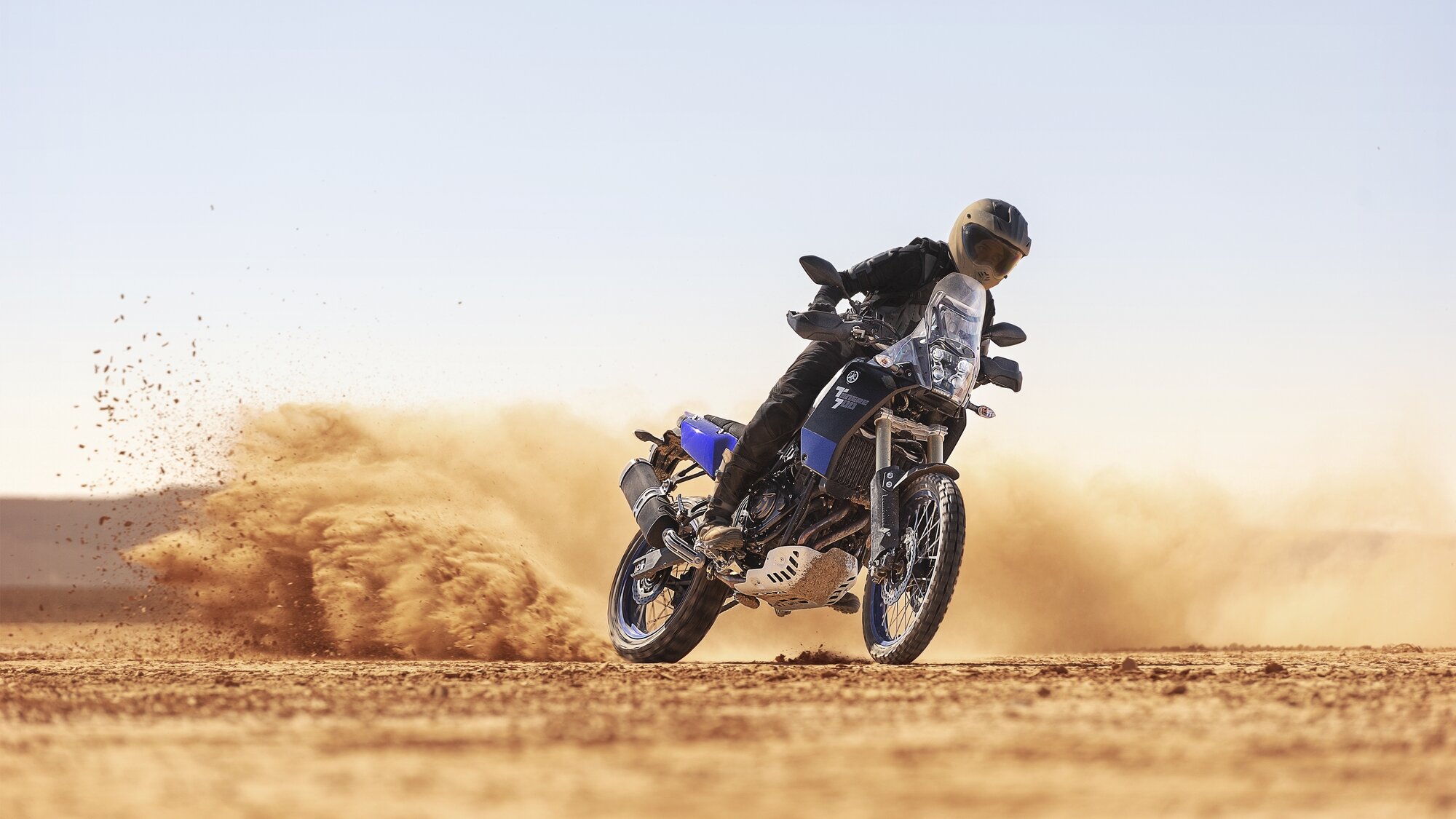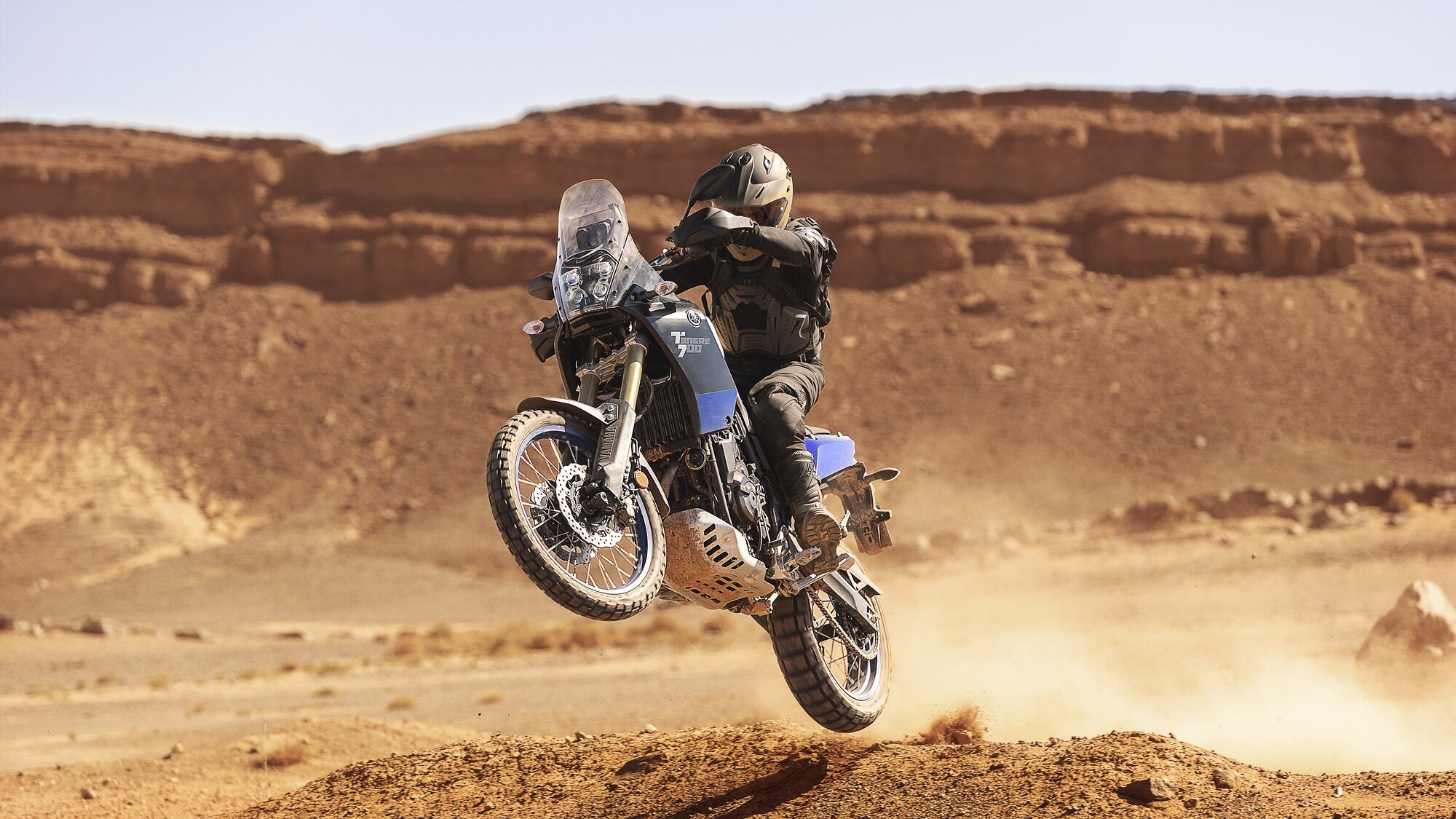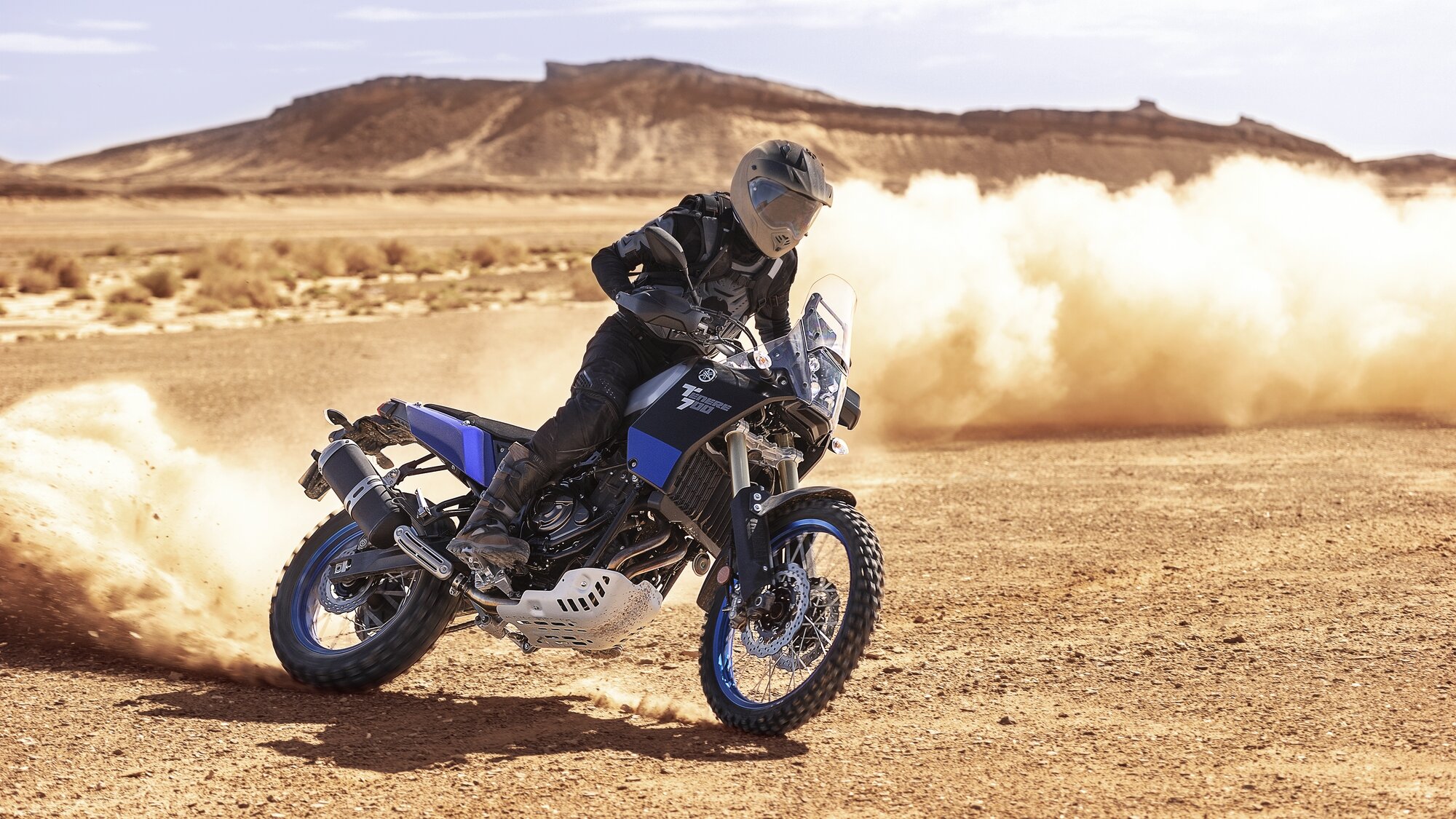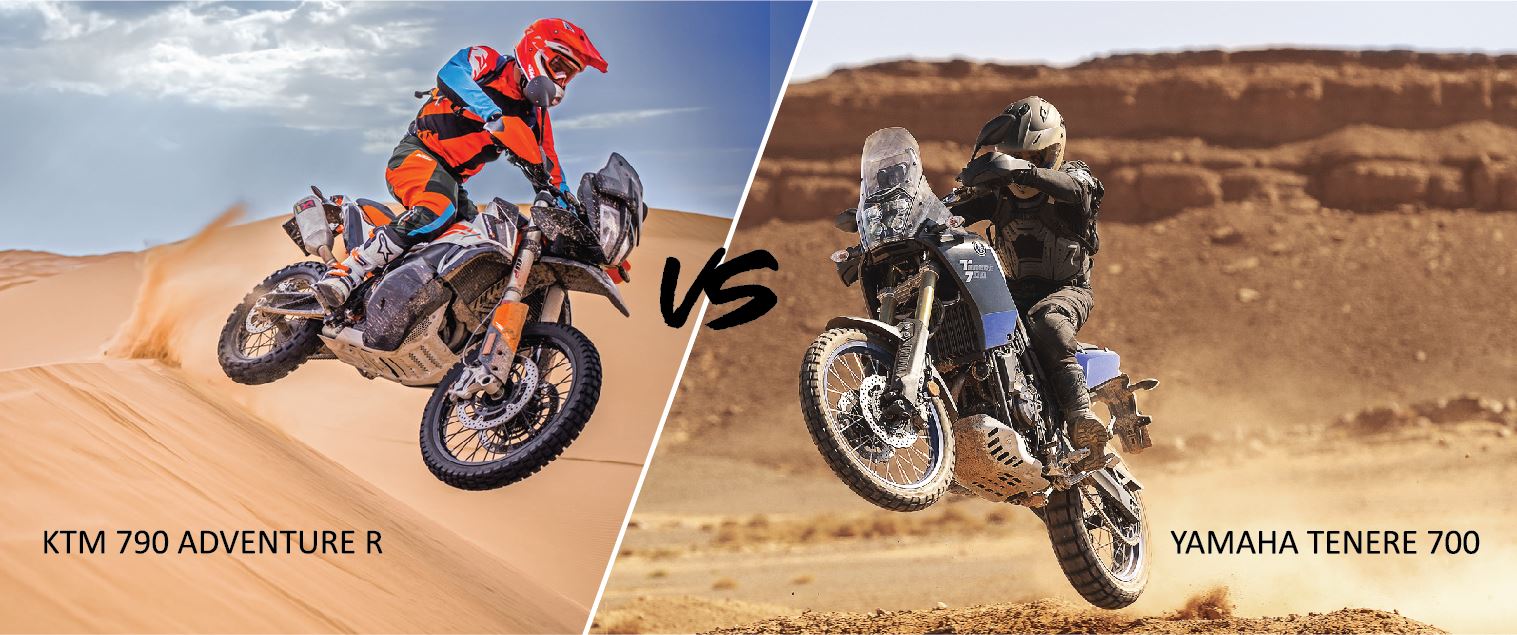KTM 790 ADVENTURE R vs YAMAHA TENERE 700
We take two adventure bikes, that unarguably, have been making the most headlines around the world, and put them head-to-head against each other - on paper at least. We use the stats and what we know to look at how the two stack up against each other.
Back in March, we previewed the Tenere 700, comparing it to the KTM 690, which you can find by CLICKING HERE. This was a little premature on our part so apologies there. The KTM 690 really lines up beside the old Tenere 660, both having a single cylinder engine. But even then, the comparison is still a little skewed. The new T7 uses the MT-07 parallel twin, putting it in the same category as the 790 Adventure R with regards to engine design. Pretty obvious right. That does leave the 690 (and Husqvarna 701) out on their own with no competition besides each other as the Tenere 660 says goodbye.
With the Australasian launch of the T7 now done and dusted (which we didn’t get an invite to by the way), the bikes are starting to roll into and out of dealerships – in Australia at least. If they aren’t in the hands of NZ pre-order riders right now, they soon will be.
So without having ridden the T7 or the KTM 790 Adventure R back-to-back, we can only speculate with specs and anecdotal evidence to compare these two machines, that in our opinion, are set to define the way we adventure ride in the future. It’s a great time to be in the sport.
ENGINE
The KTM’s LC8c is said to be the most compact performance engine on the market. Pumping out 95 hp, combined with modern electronics and a 6-speed sequential gearbox, and with an estimated 450 km fuel range. Could it be the perfect combination for extreme off-road exploration? On transport stages a smooth ride is assured thanks to two balancer shafts, which keep vibration to a minimum, and, with long service intervals of 15,000 km, you can ride for days on end without a worry.
790 Engine
Developed from the stellar MT-07, the Tenere 700 CP2 engine combines exceptional reliability and exciting power delivery in a compact, fuel-efficient package that shifts through a 6-speed transmission and punts out 76 hp. With an overall size similar to some single-cylinder motors, the 689cc fuel-injected, liquid-cooled, DOHC inline twin gives the T7 exceptional handing, while the counterbalanced two-cylinder design provides smooth, long-legged power ideal for long days in the saddle.
T7 Engine
The KTM has just over 100cc more in the power department which shouldn’t be discounted by any means. The 88x65.7mm bore/stroke, compared to the T7’s 80x68.6mm is significant, and the 790 pushes out nearly 20 more horse powers! Sometimes there is no replacement for displacement. However, the talk around the streets regarding how the Yamaha delivers that lower overall power is said to be stunning, and not considered a point towards the 790. You can have as much power as you want going to the rear wheel, but if the delivery is shit, then no amount of CC’s is going to make you happy.
Having said that, the 790 is all about tech and runs their ride-by-wire system that electronically translates the throttle commands of the rider into optimum throttle valve positions for the specific riding situation. So, you know the delivery from the 790 is going to be smooth as hell. So how to differentiate between the two? Probably the only way is back-to-back riding through varied terrain. The KTM has the power, but the Yamaha is said to put its smaller amount of power into some sensational torque delivery. Either way, sounds like a party.
SUSPENSION
The T7 utilizes a long-travel 43mm inverted fork with 210mm of travel. The inverted layout is highly resistant to flex to maintain precise steering and suspension action, and the fork is fully adjustable to match changing road and trail conditions. The linkage-type rear shock is similarly outfitted for adventure, with 200mm of travel, and a remote preload adjuster to easily fine tune for changing loads or riding conditions.
The 790 comes with high-quality WP suspension, to accommodate the many variables of travel-enduro exploration. The fully adjustable WP XPLOR 48 mm fork, with 240 mm of travel, has outstanding response and damping characteristics for extreme off-road use.The separate function for each fork leg enables the forks to be easily adjusted on the fly. On the rear end sits the WP XPLOR shock with 240 mm of travel for the most extreme offroad conditions. Suspension can be individually setup for pre-load, (high and low speed) compression and rebound.
By the stats, the 790 trumps the T7 in the suspension department hands down. On the front, the larger 48mm forks, compared to the T7’s 43mm units are a big point of difference. So is the extra 30mm of travel too. If you are wanting to head off-road, suspension travel is your friend.
On the rear, the 790 again pushes the T7 aside with a massive 40mm of extra back end travel. If you compared the pure dirt bikes from both brands, you would have to tip the scales to the KYB units on the Yamaha bikes – they are that good in OEM trim. But in the ADV realm, even though the XPLOR units can be a little fickle, I think I would take that extra travel every time. But that also makes me think that Yamaha would have for-sure had a 790 in the room during the T7 design. And characteristically, the Yamaha suspension units are the best in class. So maybe the T7 suspension and its limits are good enough?
Not having ridden them and taking into account where I would want to go riding, I’ll take the extra travel thanks.
FUEL RANGE & WEIGHT
Fuel range relates directly to weight, because the more fuel the bike can carry, the further it can go, but of course the heavier it is likely to be. Unfortunately, while Yamaha lists the T7’s wet weight (204kg), KTM only list the dry weight (189kg). So if you were to hit the numbers at a quick glance over the internet, and not notice the wet/dry disparity, you would be all over the KTM like white on rice. The fuel capacity of the 790 is 20 litres, while the T7 is only 17 litres.
But let’s do some UPDATED science. 1 litre of liquid equals roughly 0.75kg of weight. So if we add 20kgs (gas capacity and assuming oil is included the dry weight spec) to the KTM’s dry weight we get 204kgs - the same as the T7’s 204kgs. But now take into account that for those 20 litres of gas, the 790 will take you a claimed 450kms. Whereas compare that to the 17 litres on the T7 that they claim will only take you 350kms. Another 100km? Yes please.
So if both bikes weigh the same, if your honest with yourself you could probably lose 5kgs from around you're waist of your worried about weight.
But the real deciding factor should be how that weight is carried. Is it up high or down low. That will drastically change how that weight feels when riding either the 790 or the T7. And how do you find that out? Yep you guessed it – ride them back-to-back.
790 TFT display
DISPLAY
The lightweight instrument panel on the T7 displays a wide range of information that can be absorbed without having to take your eyes off the road or track. The multi-function LCD display features gear position, fuel level, two trip meters and estimated fuel range, as well as average and instant fuel consumption.
Reading valuable information like trip meter, fuel range, ABS settings and ride modes on the fly is made easy with the 790’s 5-inch, full-color, state-of-the-art TFT display. The rider can select which information and where he would like to have it displayed on the screen. The display's configuration is variable and automatically adapts to variations in environmental light. The rev counter blinks to indicate when to shift.
T7 display
KTM have gone down the route of throwing top of the line components into the 790 with seemingly no expense spared. The TFT is the go-to in display options and it’s a real shame the T7 has gone for a more conventional black and white display. Even without all the other electronic features that the 790 has over the T7, the addition of a TFT instrument panel alone would have made a huge difference in how the cockpit looks. The 790 is the latest and greatest while the T7 looks quite out dated. Though the t7 does have a bar above the dash to install a GPS or phone which I think is a blood great feature.
ELECTRONIC AIDS
Yamaha has added switchable ABS to the all-new Tenere 700. That’s it.
KTM on the other hand have thrown the book at the 790. It has rider enhanced aids up the wazoo, including traction control, cornering ABS, Off-Road ABS, Off-Road riding mode and Rally Mode. KTM state that electronic rider aids provide more control, performance and enjoyment to the rider under a wider range of circumstances.
You definitely get more control on the 790 for your average rider hands down, and probably even better performance as those aids are doing things like helping you get the power to the ground, stopping rear wheel traction loss, and improving cornering stability. Using the KTM MY RIDE system, a smartphone can be connected to the bike, which gives the rider the option of receiving phone calls, listening to music, and, using the optional app for navigation. So hands down win to KTM here – assuming you love electronic aids.
ERGONOMICS
The T7 uses a high-strength tubular steel frame with a wheelbase of 1560mm and 241mm of ground clearance. The seat height sits at 875mm with options for taller or shorter seats.
The 790 focused on strength too, utilising a tubular CroMo steel frame is with the engine acting as a stressed member. Ground clearance is 263mm and the seat height is set at 880mm. No specs were shown for wheelbase.
Seat height for both models is negligible. Clearly there is a world-wide optimal seat height and both the T7 and 790 are in it with their 5mm difference. What is interesting though is that the 790 has much more ground clearance than the T7 – which was a surprise to me. With Yamaha’s clear focus of making a very capable Off-Road machine, I would have though ground clearance was high on their list of things to prioritise?
The 22mm difference is twofold:
Firstly, you have more room to ride over things out on the trail, and less chance of smashing your sump when riding. You can have a little more confidence when slow riding knowing that you have less chance of getting hung up on something and tipping over without warning. Plus ground clearance helps to no end when in ruts and bogs. Yeah, not what 99% of riders who buy this bike will be doing but still - we like ground clearance.
Secondly, with the seat heights so close, the KTM is squeezed into a tighter space. Its weighted mass is more centralised in the middle of the bike and not stretched out a further 22mm. Though the other side of the weight coin is the T7, which has the ability to get its centre of gravity lower, as some of its engine mass sits that 22mm further down. So what you lose in ground clearance on the T7 you might make up for with in a lighter feeling, more planted bike because the weight is lower.
PRICE
Now we are down to the crux of the matter. How much is it gonna cost ya!
For the Tenere 700 you will give up $16,999 of your fun tokens.
For the KTM 790 Adventure R, you will have to stump up with $23,799 of them.
You can buy a lot of anything for $6800. That’s how much you will save if you pick the T7 over the 790. But lets take a closer look. With the 790, you get the nice TFT screen, you get all the electronic assists, you get the powerful engine, you get the ride-by-wire throttle, different engine modes, more ground clearance, larger forks and and a bike that kinda looks like nothing else out there. You would have to assume that’s easily well over $6800 worth of extras that come standard on the 790. i also like how the front mudguard is up high.
But the real question is do you need all that stuff? Yamaha priced the Tenere 700 very aggressively, meaning all the fancy extras were left on the R&D work bench. Saving yourself $6800 gets you a bike that looks seriously off-road. A bike that will give you a very real, very raw experience. It’s aggressive by nature, design and delivery and expects you to know what your doing. It looks racy and probably feels racy on the trail too. You could slap on a nice pipe, some new tyres and still have cash let in your wallet.
790 vs T7
I don’t think there is a right or wrong answer here and I know that each bike would make a great adventure machine. But personally, I would take the T7 purely on its looks and price tag. The 790 looks to fancy for my taste and almost designed visually for the road more than the dirt - in my opinion. The T7 was unmistakably made for Off-Road riding and I just love how it was designed with a minimal look.
I think the 790 would be more comfortable over the long haul and great for those who might quickly run out of talent. There is something to be said about electronic rider assist that can really save lives. But there is also something about that real raw riding experience.
It’s a great time to be in the midst of Adventure riding. So many beautiful options and not enough money to go around. Shit - sounds like another kind of party.
GALLERY
















